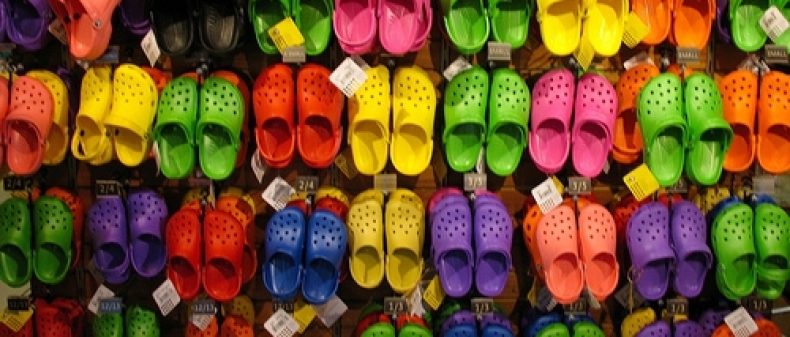
Each era has its signature footwear. In the 1990’s, Ally McBeal’s stilettos symbolized the towering optimism of the Clinton economy along with its problematic post-feminist gender politics. Women could be in the workplace, but only if they wore sexy heels that squeezed their feet into S&M contortions. The result–a decade’s worth of romantic comedies in which the lead actress falls down, preferably in front of her rakish boss slash love interest played by Hugh Grant.
After the economic slowdown of 2001, consumers sought affordable comfort over athletic contortions. Admittedly, certain women still worshiped at the altar of Louboutin, but with even Carrie Bradshaw questioning her obsession (“I’ve spent $40 thousand on shoes?!”) it was clear times were a-changing. But no one could’ve predicted the decade’s ‘It’ shoe would be made out of foam.
Like the swamp creature they’re named after, Crocs swam silently towards the unsuspecting population before lunging violently as if out of nowhere. Founded by a couple of friends in 2002 with a foam-technology developed in Quebec, the first market for the waterproof footwear were boaters. Recognizing how comfortable they were, the owners next turned to people whose jobs required a lot of standing–cooks, servers, and nurses.
By 2006, Crocs were everywhere. The fashion industry looked on, gap-mouthed and powerless in the face of their squishy march. Backlash came from high and low, with blogs, YouTube videos, and Facebook groups all dedicated to ridding the world of the popular clogs. Devotees answered any and all criticism with a defiant, “But they’re comfortable!” Having never tried on a pair myself I’ll have to take their word for it. I assume it feels like your feet are having orgasms. Comfort alone can’t explain the shoe’s phenomenal rise. Rather than be a setback or something to overlook, Croc’s instantly recognizable shape, bright colours, and the stupid little plastic charms kids stuck on them called “Jibbitz,” were all part of the appeal. Tackiness sells, sometimes very well.
The company bought ads in Vanity Fair that declared “Ugly can be beautiful.” As Mike Madden wrote on Salon, this ad got to the heart of it: “The shoes are ugly. You know they’re ugly. People knew they were ugly even as they flocked to buy them; they celebrated, they reveled in their ugliness.”
A couple factors halted Croc’s plans for world domination. The economy crashed in 2008 and the company, already overextended, had to scale back its operations. Counterfeits proliferated (nicknamed “croc-offs”) while the brand got bad PR when children wearing Crocs got stuck on escalators. But the larger problem was with the shoes themselves. The foam material it turned out lasted a long time and so eventually everyone who wanted a pair of Crocs had bought one. This is where the company could have taken a lesson from the fashion industry–people buy Louis Vuitton purses not because they need a new one, but because Marc Jacobs puts out a fresh design every season.
Crocs may have gone extinct were it not for the clever maneuvers of CEO John McCarvel, who joined the company in 2010. Overseas, Crocs had not faced as big a backlash, so the company expanded in Asia and warm-weather countries where Crocs can be worn year-round. At the same time, McCarvel recognized that, were the company to survive in North America, they would have to diversify their products.
“From the beginning we knew that having an iconic clog was a true blessing, but we also knew we had to innovate,” McCarvel told Entrepreneur before admitting that they had been so focused on selling their top product they didn’t do so early enough.
While the classic clogs still account for almost half the company’s sales, McCarvel knows the way to grow is to introduce new styles. (His ambition is to double sales in the next five years.) The company has introduced foam-soled shoes that look nothing like Crocs. Instead, they take their inspiration from fashionable shoes–wedge heels, docksiders, sneakers, and leopard-printed ballet flats. There’s even a Croc moccasin! These are Crocs that make you forget their Crocs, pairs you can slip on at the office or on a date without being publicly shamed, tarred, and feathered. Crocs will never be fashion-forward, but the new styles are meant to work with your precisting wardrobe without the garish fanfare of plastic Jibbitz. The new slogan? “A shoe for every you.” Counter to the company’s original ad campaign, beautiful can be beautiful too.
____
Max Mosher writes about style for Toronto Standard. You can follow him on Twitter at @max_mosher_.
For more, follow us on Twitter @TorontoStandard or subscribe to our newsletter.














